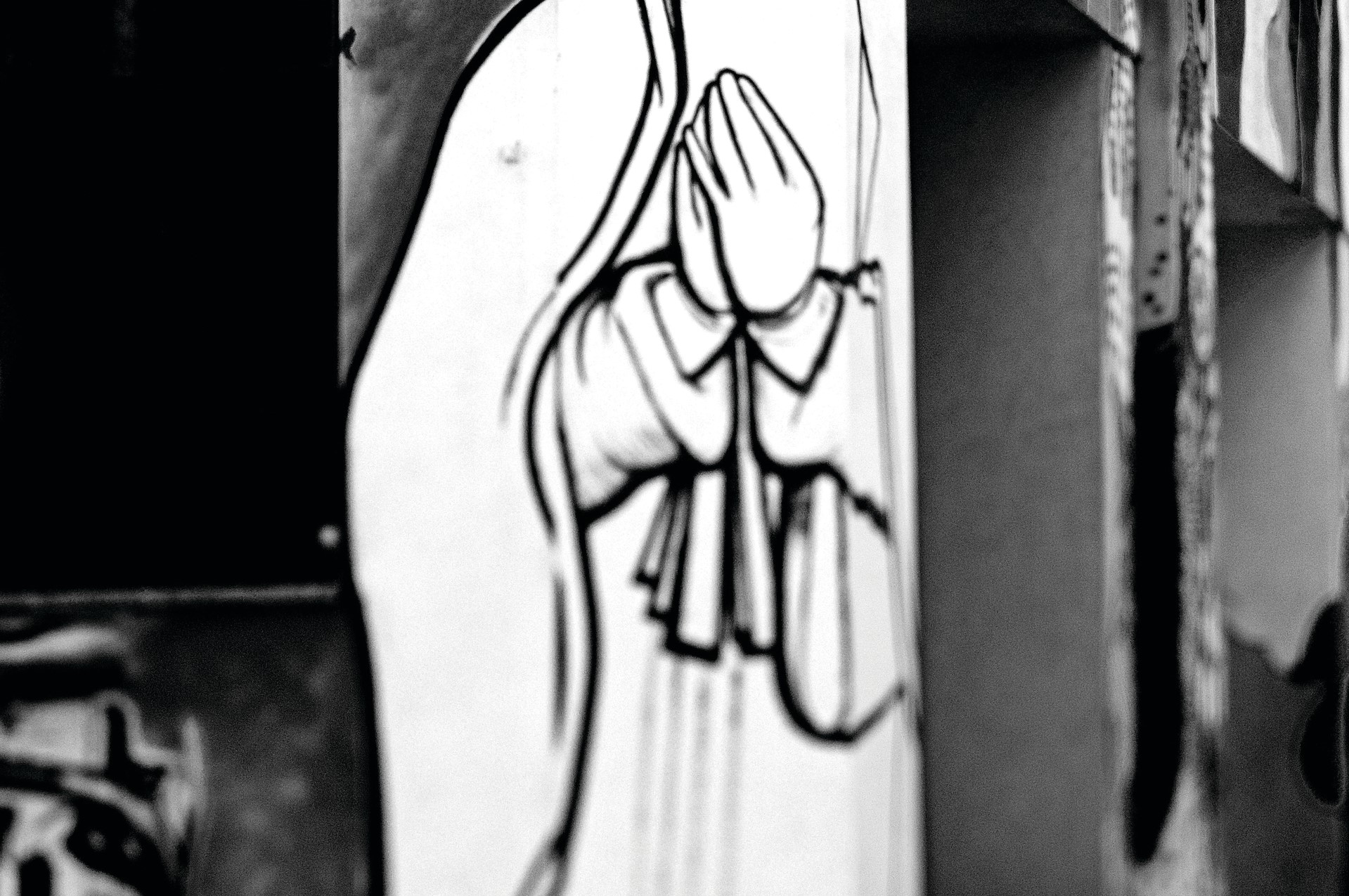
Way of life
The birth of Raphael | Issue 17 | 2020


Not far from Le Bon Marché, in the seventh arrondissement, is an orthopaedic shoe shop by the name of Labouré père et fils.
Despite its proximity, the shining clientele of Paris’ oldest department store is unlikely to venture along rue de Sèvres to Labouré, and vice versa. The beau monde flocks to Le Bon Marché, to run its manicured fingers over folded silk scarves on the ground floor, to suck in its stomach before the mirrored walls on the first, to waft up and down the tessellated staircases, looking, and being looked at. Labouré attracts a more modest following, but its patrons are no less discerning when it comes to matters podiatric. Loyal customers limp down to the chausseur, seeking relief from their achilles tendonitis, their bunions, blisters and corns. On the whole, the ladies and gentlemen who come to admire the impressive array of shock-absorbing insoles and cushioned slip-ons are Parisians of pensionable age; but Labouré has also attended to the pieds sensibles of many a grateful tourist, unused to trudging the city streets. And recently, it has also reached out to the younger generation with a new range of summer sandals in pale blue and pink.
Among its regulars, Labouré also counts the Daughters of Charity of Saint Vincent de Paul, who often pause at the shop window on their way from the convent on rue du Bac to the Chapel of their founder on rue de Sèvres. It was at Labouré that Sister Catherine Brunet, arriving in Paris in 1982 to take up her vocation, and finding that her heeled button boots were ill-suited to the peripatetic life of an urban novice, acquired the first of many pairs of functional black leather lace-ups that she favoured for the rest of her life. She eventually gave away the boots, but she kept her treasured pair of Clarks’ sheepskin slippers which her sister had brought back from England. (The convent could be cold in winter.)
Sister Catherine’s route through life to the motherhouse of the Daughters of Charity on rue du Bac had not been easy or direct. She had the early misfortune of being born the youngest, by some years, of three sisters, the eldest of whom was exceptionally intelligent, the second exceptionally beautiful. From a young age, she disappointed her mother by having hair that did not curl naturally and a nose that was just a little off-centre. Her father, an accountant with France’s largest manufacturer of rigid plastic packaging, was exasperated by his daughter’s inability to grasp even the simplest arithmetical concepts. It was his penance for having produced a child as slow as Catherine that two hours every Sunday evening should be given over to the grim and plainly futile task of tutoring her, a routine that invariably provoked him to rage and her to tears. As he stood behind her chair, barking instructions and deploring her incompetence – good heavens girl…carry the six…the SIX! You haven’t listened to a word…I said DIVIDE! – they separately wondered what they had done to deserve this peculiar punishment, without it occurring to either that it was in any way avoidable or unnecessary.
If this were a novel, now would be an appropriate moment to introduce the hero of the piece, probably a wealthy young man, definitely handsome, who prefers girls with straight hair and has no great aptitude for mathematics himself. He would meet Catherine in the boulangerie, after a small confusion when he picks up her ficelle by mistake and she is given his baguette. Captivated by her innocence and simplicity (so unlike the brash society ladies that generally throw themselves at him), he begs to see her again. Several clandestine meetings ensue, a declaration of love, a marriage proposal; they reveal all to her shocked but delighted parents and are married in the small church of Saint-Etienne where she was baptized. Everybody agrees that straight hair is much prettier than curly, and the girls go home to iron their tresses flat.
However, we are not conjurers, and we cannot report what we know did not happen. There were times, after her sister Élisabeth had married, when Catherine would take out the tulle bridal veil and try it on, wondering at its gossamer touch. Then she would whisper the words of the Sacrament of Matrimony from the Missale Romanum, and it seemed to her that there was no greater enchantment. But the current of Catherine’s life did not carry into her path any suitor, rich or poor. No fairy-tale romance was spun for her, and she realised, before she was very old, that without the advantages of symmetrical features and a superior intellect, she would have to weave a different design for herself. This was not a sadness for her, but a liberation of sorts.
Not long after Élisabeth’s wedding, Monsieur Brunet suddenly died. This event, no less significant in Catherine’s life as it was, inevitably, in his, brought her a little closer to emancipation. On the evening in question, she was summoned, shortly before seven o‘clock, to her father’s study. As the scene of so many Sunday-night humiliations, it was not a place she visited willingly, but she would not have dared to refuse him. She found Monsieur Brunet standing before the fireplace and holding a cornichons jar full of one- and five-centime pieces. It had stood for years on the mantelshelf in that room.
“Catherine” he said, “I have a game for you. I will bet you ten francs that you cannot guess the value of the coins in this jar.” Few people enjoy playing games that they know they have no hope of winning, and Catherine was not unusual in this respect. She opened her mouth. “No, Catherine, think about it first. It’s no fun if you don’t think properly.” Catherine frowned miserably at the jar and pretended to be making calculations in her head. When she judged that a suitable amount of time had elapsed, she said, at random:
“Ninety-four francs and seventy-two centimes,” and waited for his contempt.
“Let’s see if you’re right.” He tipped the contents of the jar onto the desk and began to count. Catherine looked out of the window at the milky dusk. A woman was walking two Pekinese dogs past the house. One sniffed at her father’s laburnums and paused to squat, a look of thoughtful concentration on its face.
“Well, well.” She looked down at the desk, at the neat little piles of coins he had arranged on the blotter. “Ninety-four francs and seventy-four centimes!’ he said triumphantly. “Seventy-four…bad luck my girl.” He began cheerfully shovelling the coins back into the jar. When this was done, he looked expectantly at Catherine, and she realised he was awaiting payment. She gave him a ten-franc piece from her purse and left him chuckling to himself as he placed the jar back on the mantelshelf. It was the last time she saw him alive, probably the last time anybody saw him alive.
Monsieur Brunet did not make it to bed that night, but as he and Catherine’s mother had kept separate rooms for as long as anyone could remember, he was not missed. It was only in the morning that he was discovered, and it might have been longer still, had somebody not noticed the unread Le Figaro on the doormat and, thinking it odd, checked his study.
Catherine’s mother was writing letters in the dining-room when she was told.
“Oh dear,” she said. “I suppose I had better see him.” And she sighed slightly as she laid down her pen.
Everyone gathered in the doorway of the study. Monsieur Brunet was sitting in his armchair, eyes closed, a slightly strained expression on his face as if he were about to break wind. A half-drunk glass of cognac was on the table next to him.
Catherine’s mother advanced into the room, picked up the glass and sniffed it. She leaned to feel her husband’s forehead, as if taking his temperature, and noticed Catherine’s ten francs, still clutched in his hand. Briskly, she prised it from his fingers. “Catherine, you had better call the doctor.” And she closed the door behind her.
After Monsieur Brunet had passed away, and Madame Brunet had taken permanently to her bed, Catherine found herself in the strange and rather alarming position of first person. Her sisters had both fled; Agnès had gone to lecture in America – was quite celebrated in certain academic circles – and Élisabeth had moved to Zurich with her husband. Catherine remained in the family house in Blagnac, in the Toulouse suburb where she was born. She remained, in fact, in the same bedroom, with the peppermint-green wallpaper and a window overlooking the tradesman’s entrance. And, at first, she perpetuated the old routines of the household, without questioning their relevance in this altered world of hers. Every night, before she went to bed, she checked the electrical appliances to see that they were switched off and the plugs removed from the sockets – a favourite practice of her father’s, designed to prevent ‘surging’, whatever that might be. She continued to curl her hair, though sleeping in rollers gave her headaches; and she ate fish for supper every Friday, though she did not care for the taste and the slimy skin always made her feel queasy.
Quite how Monsieur and Madame Brunet would have reacted to their youngest daughter’s vocation was never tested, because they never knew of it. What visions Catherine might have had as she sat, late in the night by her mother’s bedside, what conversations played out in her head as she changed the sheets and swept the floors and spooned morsels of brioche soaked in milk into her mother’s unwilling mouth, she never spoke of and we cannot say. In the last weeks of her life, as Madame Brunet tripped and swerved through her memories – fingers whirling in the air as she mimed a lifetime of knitting, cooking, washing, sewing, calling out now to her husband, now to her own mother, naming places and people Catherine did not recognize in a single, breathless incantation – the two women briefly met and perceived each other. And though no words were spoken, Catherine saw, at the last, her chance.
Now, on the low, white steps of the Chapel of Saint Vincent de Paul on rue de Sèvres, Sister Catherine finds expectant bodies, often also an excited puppy, eager to speak, recognising her as one who will listen. The sisters no longer wear their traditional starched, ship-like wimples, but their blue-grey habits and veils and their sensible black shoes from Labouré mark them out as benevolent. People pour out their anguish to her, their anger, what he said, what she said, what he said back. They do not question whether she wants to hear; they assume that is why she is there.
© Norton Rose Fulbright LLP 2026